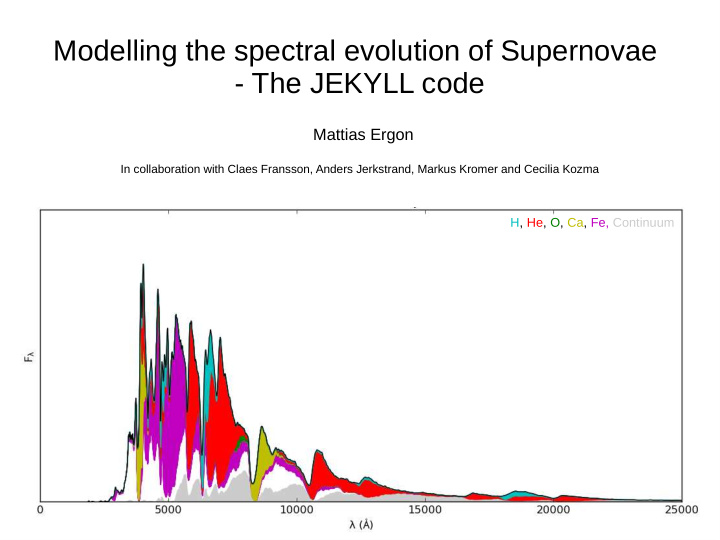



Modelling the spectral evolution of Supernovae - The JEKYLL code Mattias Ergon In collaboration with Claes Fransson, Anders Jerkstrand, Markus Kromer and Cecilia Kozma H, He, O, Ca, Fe, Continuum
The JEKYLL code What: Realistic* simulations of the spectral evolution and lightcurves of SNe in the photospheric and nebular phase. How: Full NLTE-solution for the matter and the radiation field, following (and extending) the MC method outlined by Leon Lucy (2002, 2003, 2005). Key ingredients: Non-thermal electrons and macroscopic mixing. * Restrictions: Homologous expansion. Spherical symmetry. Steady-state for the matter.
Method outline Matter Electron temperature Thermal equilibrium Ion level populations Statistical equilibrium Lambda iteration Non-thermal electrons Spencer-Fano equation Time iteration Radiation field (MC) Radiative transfer Homologous expansion
Other similar codes SEDONA (Kasen et al. 2006) SUMO (Jerkstrand et al. 2011) Geometry: 3-D Geometry: 1-D NLTE: No NLTE: Full Non-thermal ionization/excitation: No Non-thermal ionization/excitation: Yes Time-dependence: No Time-dependence: Radiation field Macroscopic mixing: Yes Macroscopic mixing: Yes Phase: Nebular Phase : Photospheric JEKYLL (Ergon et al. In prep.) Geometry: 1-D NLTE: Full Non-thermal ionization/excitation: Yes Time-dependence: Radiation field Macroscopic mixing: Yes Phase: All ARTIS (Kromer et al. 2009) CMFGEN (Hillier 1998) Geometry: 3-D Geometry: 1-D NLTE: Ionization NLTE: Full Non-thermal ionization/excitation: No Non-thermal ionization/excitation: Yes Time-dependence: Radiation field Time-dependence: Full Macroscopic mixing: Yes Macroscopic mixing: No Phase : Photospheric Phase: All
Comparisons SUMO ARTIS In progress. CMFGEN T.B.D. Early lightcurves for model 12C Nebular spectra model 13G
Application to a Type IIb model Preferred model for SN 2011dh from Jerkstrand et al. (2015), where it was evolved through the nebular phase with SUMO. Evolved through the early phase with JEKYLL in Ergon et al. (In prep.) 56Ni M In = 12M ⊙ M Ej = 1.7 M ⊙ He C/O H M Ni = 0.075M ⊙ 50 erg E K = 6.8 × 10
Type IIb model: Spectral evolution Model: Before 150 days H, He, O, Ca, Fe, Continuum
Comparison to SN 2011dh: Spectral evolution Model and SN 2011dh – Before 150 days
Comparison to SN 2011dh: Lightcurves Model (circles) and SN 2011dh (crosses): Before 150 days
Effect of NLTE: Bolometric lightcurve Model: Before 100 days Model 12C : 3-100 days
Effect of NLTE: Bolometric lightcurve Model: Before 100 days Model 12C : 3-100 days Non-thermal ionization/excitation - Off
Effect of NLTE: Bolometric lightcurve Model: Before 100 days Model 12C : 3-100 days Non-thermal ionization/excitation - Off NLTE excitation - Off
Effect of NLTE: Spectral evolution Non-thermal ionization/excitation - On/Off
Effect of NLTE: Bolometric lightcurve Model: Before 100 days Model 12C : 3-100 days LTE + Opacity floor (HYDE)
Effect of NLTE: Bolometric lightcurve Model: Before 100 days Model 12C : 3-100 days LTE + Opacity floor (HYDE) Arnett (1982) + Popov (1991)
Effect of NLTE: Bolometric lightcurve Model: Before 100 days Model 12C : 3-100 days Model 12C : 3-100 days 2 -1 HYDE opacity floor : 0.024, 0.05, 0.1, 0.15, 0.2 cm gram
Effect of mixing: Bolometric lightcurve Model: Before 100 days Microscopic Mixing Macroscopic Mixing
Effect of mixing: Spectral evolution Macroscopic mixing - On/Off
Thanks ...
Recommend
More recommend